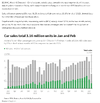@sptrawler... rcw1 company owns a Tesla.. don't get to drive it though kin do that... rcw1 just washes it... ha ha ha ha ha ha
To rcw1 knowledge its going great guns... certainly got some tow in it... The only electric car on the books and racks up some good k's. no problems with charging or otherwise. East coast far northern and northern parts of Queensland.
To rcw1 knowledge its going great guns... certainly got some tow in it... The only electric car on the books and racks up some good k's. no problems with charging or otherwise. East coast far northern and northern parts of Queensland.







